�
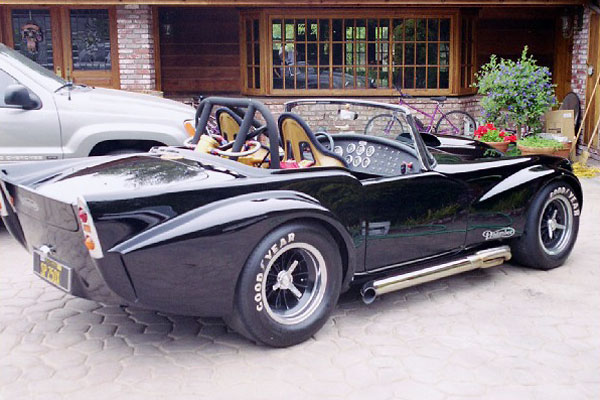
�
Steve Sanett's 1962 Daimler SP250 with aluminum Chevy 427 V8
� as published in BritishV8 Magazine, Volume XVII Issue 1, July 2009�� Owner: Steve Sanett
� � City: Chatsworth, CA
� Model: 1962 Daimler SP250
� Engine: 427cid Chevy/Dart aluminum V8
� Conversion performed by: owner�
�
Background Information
��
Daimler was a British specialty car manufacturer. They built their first car in 1896.�
Historically, Daimler was probably best known as the preferred supplier of limousines �
to the British royal family. �
�
The company's name has caused much confusion over the years. In Daimler's early days, �
they built their own engines using patents licensed from the more famous German �
company of the same name. However, in terms of actual ownership and management, the �
two companies were entirely seperate. �
�
Toward the end of a long series of distinctive up-market cars, Daimler introduced a �
fast new roadster called the "Dart" at the 1959 New York Motor Show. The Daimler Dart �
was met with interest, but the model name had to be abandoned because Dodge had already �
trademarked it for their hugely successful economical compact. Daimler re-named their �
Dart model "SP250" for the U.S. market. (They continued using the name "Dart" in �
other markets.) �
�
The SP250's fiberglass body was mounted on a tubular steel, ladder chassis. In 1960 �
Daimler was acquired by Jaguar. Jaguar frankly felt that the original Daimler SP250 �
chassis was crude and dangerous, so they immediately redesigned it. They even went so �
far as to have all unsold, exported SP250's shipped back to England to be torn down and �
rebuilt. The improved SP250 was designated "B Series". �
�
All Daimler SP250's were built with 2.5L V8 engines which produced about 140 BHP and �
featured aluminum cylinder heads, hemispherical combustion chambers, two valves per �
cylinder, and a single camshaft. By many accounts this was an excellent engine, but �
it had no hope of being popular in the power-hungry U.S. markets due to its small �
displacement, high cost, very limited service and parts support, etc. Performance �
enthusiasts had to modify the engine to get the most out of it: from stock it had a �
compression ratio of only 8.2:1. At about 419 pounds, the Daimler V8 weighed over 100 �
pounds more than a 3.5L Buick/Rover V8.�
�
When production of the SP250 sports car was cancelled at the end of 1964, only 2654 �
had been sold. Although the cars are rare, it's not uncommon to find SP250 engine �
conversions, or to find potential project cars offered for sale without engine.�
�
The Daimler 2.5L engine was somewhat more successful than the SP250 car. It was used �
in a Daimler-badged variant of the Jaguar "Mk II" saloon through 1969. Total production �
of the engine surpassed 20,000 units. Reportedly, after Jaguar merged with BMC the �
Daimler V8 was considered for use in other sports cars, including an MGB variant.�
�
Steve Sanett imagined what an SP250 might be like with comfortably more than �
250 percent more engine displacement, power, and torque. �
�
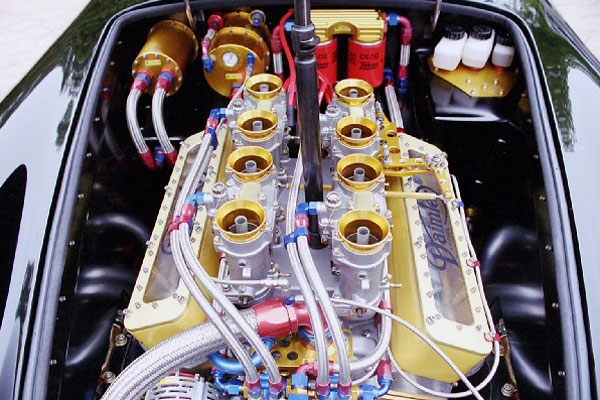
�
Dart all aluminum 427cid Chevy engine block with Air Flow Research 225cc heads.
�
How It Was Done
�| Engine: | �Dart all aluminum 427cid Chevy with Air Flow Research 225cc heads and titanium �
valves. J.E. pistons (12.5:1), Carrillo rods, Cola crankshaft, Jessel belt drive.�
Solid roller cam by Comp Cams (252 degrees intake, 248 degrees exhaust, at �
0.050"/ 0.610" valve lift. 108 degree lobe separation.) MacKay magnesium �
intake manifold. 48IDA Weber carbs bored to 51mm with custom 46mm secondary�
venturis. Mallory Super Mag (magneto transformer) 80-amp ignition. Aviaid �
4 stage dry sump oiling system. Custom billet aluminum valve covers with clear �
Lexan inserts back-engraved with the Daimler logo. Custom billet aluminum surge �
and breather tanks. | �
| Cooling: | �Ron Davis custom aluminum radiator, plumbed with dash 24 Aeroquip hose and fittings.�
Dual electric fans. | �
| Exhaust: | �custom polished stainless steel headers with 1.750" primaries. 3.5" stainless �
steel side pipes. | �
| Transmission: | �Borg Warner Super T10 close-ratio 4-speed. (Top gear is 1:1). Custom driveshaft. �
Tilton triple organic clutch disc. Aluminum flywheel. Hydraulically actuated. | �
| Rear Axle: | �Speed Way Engineering quick change with Detroit Locker and 3.11:1 gears. | �
| Front Suspension: | �modified Daimler double wishbones (converted to Heim joints). �
Koni double adjustable aluminum coilover shock absorbers. �
Custom anti-sway bar.�
Converted to rack and pinion steering. | �
| Rear Suspension: | �Koni double adjustable shock absorbers. | �
| Chassis: | �re-welded all factory tubing. Surprisingly, we were able to re-use the original�
(Daimler V8) engine mounts. The rear section of the frame was modified for stiffness�
and also to accept telescoping shocks. The upper �
shock mountings are actually mounted to the roll bar in the trunk area. An ATL fuel cell was installed in �
a custom aluminum enclosure. Custom billet aluminum gas cap.�
All bolts are 12-point MS21230 Mil spec. | �
| Body: | �all quarter panels were pulled. The rear quarter panels were vented. (See photo.)�
All handles were shaved. Stainless steel trunk and hood hinges were custom �
made. Cobra reverse hood scoop. Front blinkers were removed. Front grille�
was reshaped. | �
| Interior: | �custom aluminum dashboard. Sparco (Kevlar composite) seats with 5-point �
Sparco harnesses. Door panels and dashboard custom upholstered in Connely hide. �
Custom roll hoop with Petty bar. | �
�
| Wheels/Tires: | �PS Engineering "Cobra" (Halibrand style spline drive aluminum wheels with �
tri-wing knock-offs) 15x8.5 front / 15x10.5 rear. Goodyear "Blue Streak" �
racing tires. | �
| Brakes: | �Girling aluminum "18-4" 4-piston calipers and 11.5x1.25 vented rotors. | �
| Electrical: | �custom wiring featuring Teflon insulated silver wire and aluminum �
MIL STD connectors. All switches feature silver contacts. MIL STD �
aircraft circuit breakers.�
Stewart Warner mechanical gauges. Jones Motrola Corp. mechanical tachometer. �
Dual SLA (sealed lead acid) batteries on custom aluminum battery trays. �
Onboard fire suppression system. | �
| Performance: | �engine dyno specs are 540 HP at 7100rpm, 575 LB FT torque at 4150rpm.�
52% / 48% weight distribution. Engine was moved back about six inches from �
the original (Daimler V8) location. 0-60mph in 3.3 seconds. | �
| Weight: | �2400lbs. | �
| Completed: | �driven about 1020 miles since the conversion was completed in 2000. | �
| Comments: | �building this car was a 10 year project and a substantial learning experience.�
Our concept was to show what might have been if Daimler had wanted to go�
racing against Shelby in the 1960's. The project touched on many aspects of�
automotive and aerospace technology - all merged into an old British car!�
It was fun, tedious, and VERY expensive, but worth every penny and every�
minute spent. | �
�
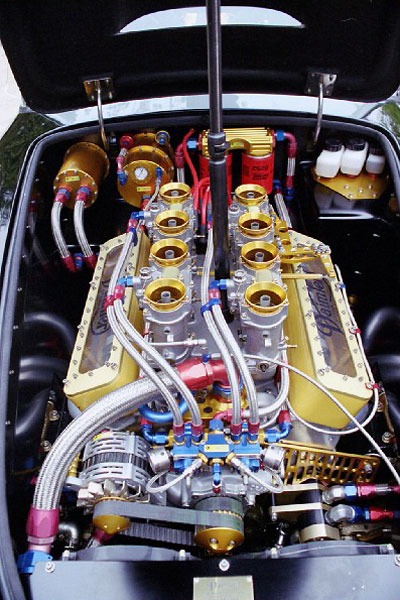
�
48IDA Weber carbs bored to 51mm with custom 46mm secondary venturis.
�
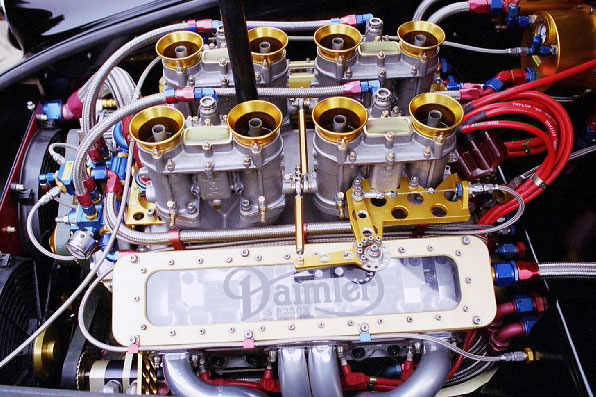
�
Custom aluminum valve covers with clear Lexan inserts.
�
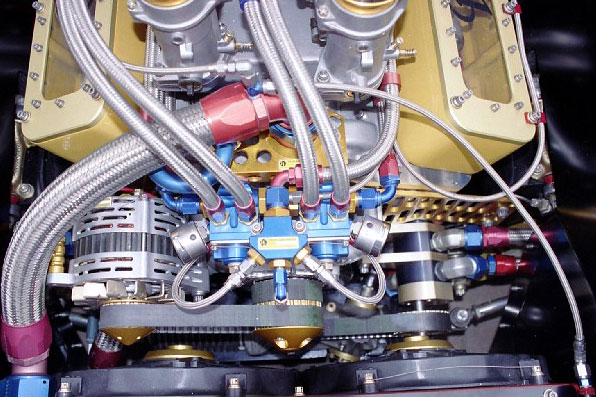
�
Aviaid 4 stage dry sump oiling system.
�
�
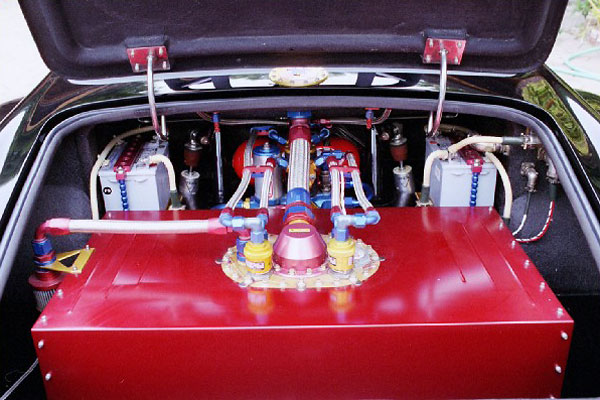
�
ATL fuel cell installed in a custom aluminum enclosure.
�
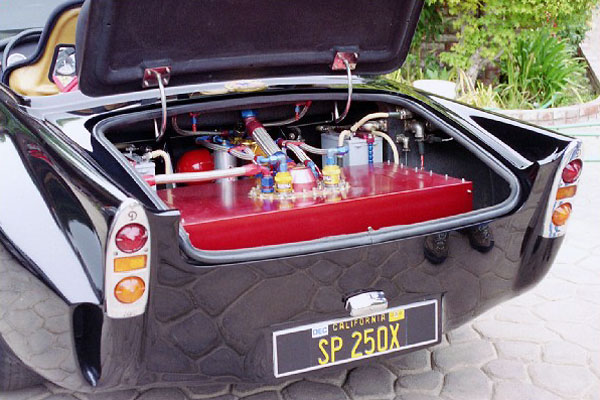
�
Vents have been carved into the rear fenders, outboard of the tail lamps!
�
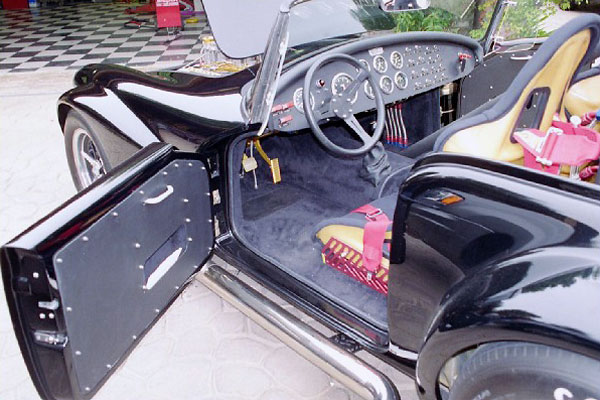
�
Custom door panels and dashboard. Modern Sparco composite seats.
�
�
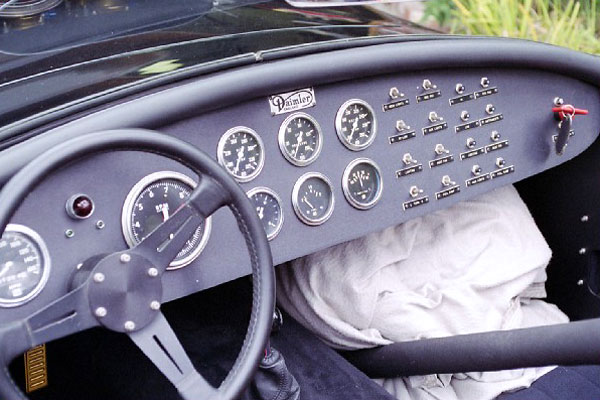
�
Stewart Warner mechanical gauges. Jones Motrola mechanical tachometer.
�
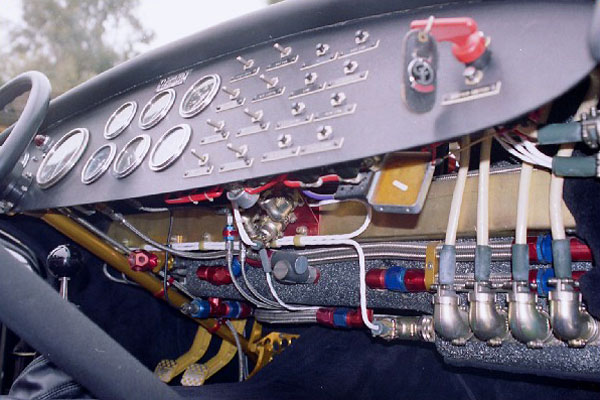
�
Teflon insulated silver wire and aluminum MIL STD connectors.
�
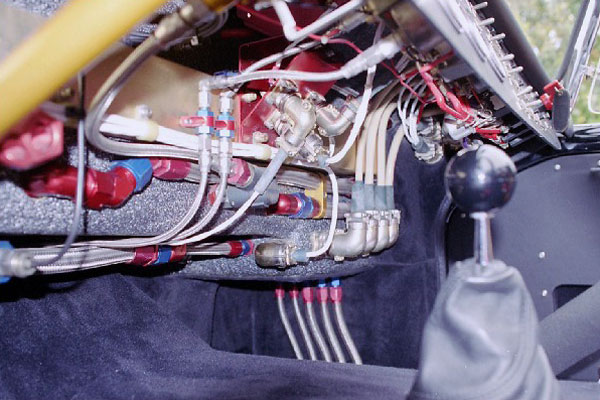
�
Extensive Aeroquip plumbing, as required for the mechanical gauges.
�

